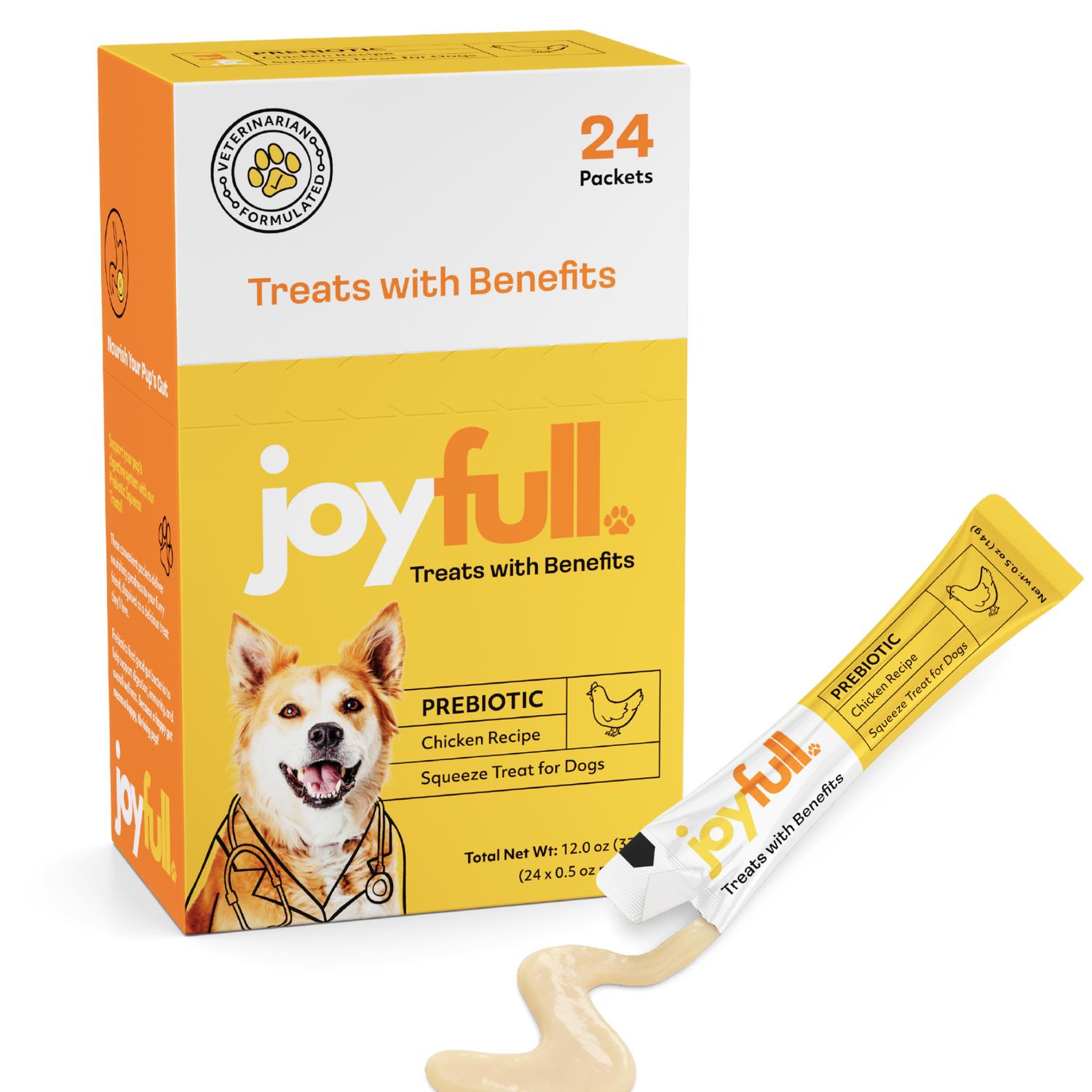
What Causes Gas in Dogs? Causes & Tips for a Happier Pup
Let's be honest, every dog passes gas. It's a perfectly normal part of digestion. But when your dog's toots become frequent, room-clearing events, it's usually a sign that something is a little off balance in their digestive world. The cause almost always boils down to their diet, their eating habits, or a potential health issue that needs a closer look.
Why Is My Dog So Gassy? Understanding the Root Causes
Think of your dog’s gut as a complex ecosystem. When everything is in harmony, digestion is smooth and, well, quiet. But introduce the wrong elements—like hard-to-digest foods or a rushed meal—and you disrupt that balance, leading to the smelly byproduct we all know: gas.
Figuring out the "why" is the first step to a less gassy home. Most of the time, the culprit falls into one of three buckets:
- The Food Itself: What's in your dog's bowl is the single biggest factor.
- How They Eat: A dog that inhales their food is also inhaling a lot of air.
- Their Overall Health: Sometimes, excessive gas is a symptom of a deeper medical problem.
So, what’s happening on a biological level? The main reason for gas is often what veterinarians call "dietary indiscretion" or simply feeding foods that are tough for a dog's system to break down. When ingredients like soybeans, peas, beans, high-fat table scraps, or dairy products hit their stomach, they can pass through undigested into the colon.
Once there, the gut bacteria have a feast. This fermentation process is what produces a surprising amount of gas. You can find out more about how diet affects canine digestion from veterinary experts.
Identifying whether the problem lies in your dog's food, their mealtime habits, or their health is crucial. It helps you know if you're dealing with a simple fix or a warning sign that warrants a call to the vet.
Ultimately, a gassy dog isn't trying to be disruptive; their body is sending a message. Pinpointing the source is the key to restoring comfort to your dog's gut and peace to your household. Let's dig into each of these potential causes to find a solution.
Quick Guide to Common Causes of Dog Gas
To simplify things, here's a quick breakdown of the most common triggers for gas in dogs. Understanding these categories can help you narrow down the source of the problem much faster.
| Cause Category | Specific Triggers | Primary Mechanism |
|---|---|---|
| Dietary Issues | Low-quality fillers (corn, soy), legumes (peas, beans), dairy, high-fat foods, spicy foods, sudden food changes. | Fermentation. Indigestible ingredients travel to the colon where gut bacteria break them down, producing gas. |
| Eating Habits | Eating too quickly, competition with other pets for food, eating from a raised bowl (in some cases). | Aerophagia. Swallowing excessive amounts of air while eating, which then has to be expelled. |
| Health Conditions | Food allergies/intolerances, IBD (Inflammatory Bowel Disease), pancreatitis, parasites, GI infections. | Malabsorption & Inflammation. The digestive tract is unable to properly absorb nutrients, leading to gas, bloating, and other symptoms. |
Knowing these primary drivers gives you a solid starting point. Now, we can explore each of these areas in more detail to help you find the right fix for your furry friend.
2. The Food Factor: How Your Dog's Diet Drives Gassiness
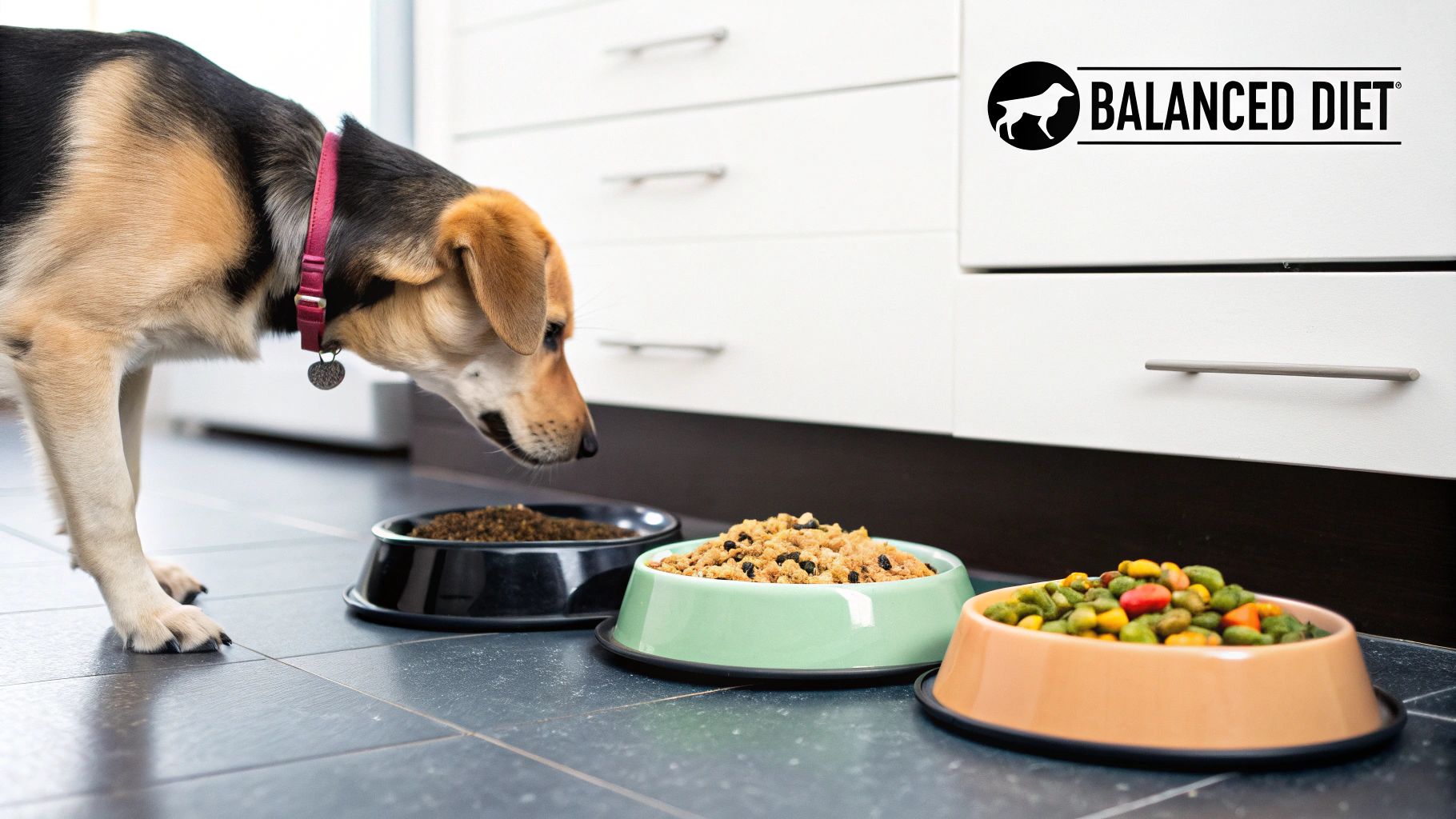
When it comes to your dog's gassiness, what's in their food bowl is almost always the biggest piece of the puzzle. It’s best to think of their diet as fuel for their digestive engine. Put the right, high-quality fuel in, and the engine runs smoothly. But use the wrong kind or a low-quality mix, and you’re bound to get some serious backfiring.
Ironically, what you might think is a "healthy" choice could be the very thing causing the problem. Many popular dog foods, particularly some grain-free formulas, are loaded with ingredients that are surprisingly tough for a dog's gut to handle.
Common Gassy Ingredients to Watch Out For
So, why do certain foods turn your dog into a little gas machine? It all comes down to a process called fermentation. When ingredients aren't fully broken down in the stomach and small intestine, they travel on to the colon. The gut bacteria living there see this undigested food as a feast, and as they ferment these leftovers, they produce gas as a very smelly byproduct.
Keep an eye out for a few common culprits on the ingredient list:
- Legumes and High-Fiber Veggies: Peas, beans, lentils, and chickpeas are everywhere in modern dog food. While they add protein and fiber, they also contain complex carbs that dogs just aren't built to digest completely.
- Dairy Products: Just like many humans, a lot of adult dogs are lactose intolerant. A little cheese or milk might seem like a nice treat, but it can lead to major digestive upset, including gas, bloating, and diarrhea.
- Low-Quality Fillers: Cheaper dog foods often rely on fillers like corn, wheat, and soy to add bulk. These ingredients don't offer much nutritional value and are well-known triggers for gas and other digestive issues in sensitive pups.
A sudden switch in your dog's food can also unleash a temporary gas storm. Their gut bacteria get used to one type of diet, and changing it abruptly throws that delicate ecosystem into chaos.
The Trouble with Table Scraps
Slipping your dog a few bites from your plate feels like an act of love, but it's often a direct contributor to their flatulence. Our food is usually far too rich, fatty, or seasoned for a dog’s digestive system to process properly.
Veterinary experts agree that treats should make up no more than 10% of a dog's daily calories. This is especially critical for brachycephalic (flat-faced) breeds like Boxers, Pugs, and French Bulldogs, who are naturally more prone to digestive issues.
Your best defense is knowledge. By learning how to read dog food labels, you can spot potential troublemakers and choose foods with high-quality, easily digestible ingredients. Making an informed choice helps create digestive peace, letting both you and your furry companion breathe a little easier.
Beyond the Bowl: Your Dog's Eating Habits
So, you've done your homework. You’ve picked out a high-quality, easily digestible food, but your dog is still clearing the room with their gas. If this sounds a little too familiar, the problem might not be what they’re eating, but how they’re eating it. It’s a factor that many dog owners miss, but the speed at which your dog eats plays a huge part in how gassy they are.
The technical term for this is aerophagia, which literally translates to "swallowing air." When a dog practically inhales their food in a matter of seconds, they aren't just swallowing kibble—they're gulping down mouthfuls of air right along with it. All that trapped air has to find a way out, and it often exits as loud, and sometimes smelly, flatulence.
It’s a bit like chugging a can of soda. You know you’re going to swallow a ton of air with the liquid, and a few burps are pretty much guaranteed. It's the same basic principle for a speed-eating dog, except the air gets trapped much further down the digestive system.
The Speed Eaters and Breeds at Risk
While any dog can develop a habit of gobbling their food, some are definitely more prone to it. If you have more than one dog, you’ve probably seen mealtime turn into a race. This kind of competitive environment encourages every dog to eat as quickly as they can, just to make sure they get their fair share.
Certain breeds are also just built in a way that makes swallowing air more common. Brachycephalic (or flat-faced) breeds like bulldogs, pugs, and boxers often have a harder time, struggling with more gas because of their unique facial and respiratory anatomy. On top of that, studies suggest that overweight and less active dogs also tend to have more issues with chronic gas, no matter what’s in their bowl. You can discover more insights about these risk factors on DVM360.com.
The good news is that aerophagia is one of the easiest causes of gas to manage. The solution is surprisingly simple: get your dog to slow down. By turning mealtime from a frantic sprint into a more thoughtful activity, you can dramatically cut down on the amount of air they swallow.
Simple Tools to Slow Down Eating
Getting your dog to take their time does more than just reduce gas. It gives them some much-needed mental stimulation and can even help prevent serious conditions like bloat. Luckily, there are some great tools out there to help you transform your dog's eating habits.
- Slow-Feeder Bowls: These are genius. The bowls have built-in mazes and obstacles that your dog has to navigate to get to the food. What was once a 30-second meal can easily become a 5-10 minute engaging activity.
- Puzzle Toys: Food-dispensing puzzle toys make your dog work for their dinner. They have to roll, nudge, or figure out the toy to get a few pieces of kibble out at a time, which is fantastic for their brain.
- Lick Mats: If you feed wet or raw food, lick mats are a game-changer. You just spread the meal across the textured surface, which encourages licking instead of gulping. It’s also a naturally calming behavior for dogs, which is a great bonus.
When Gas Signals a Deeper Health Problem
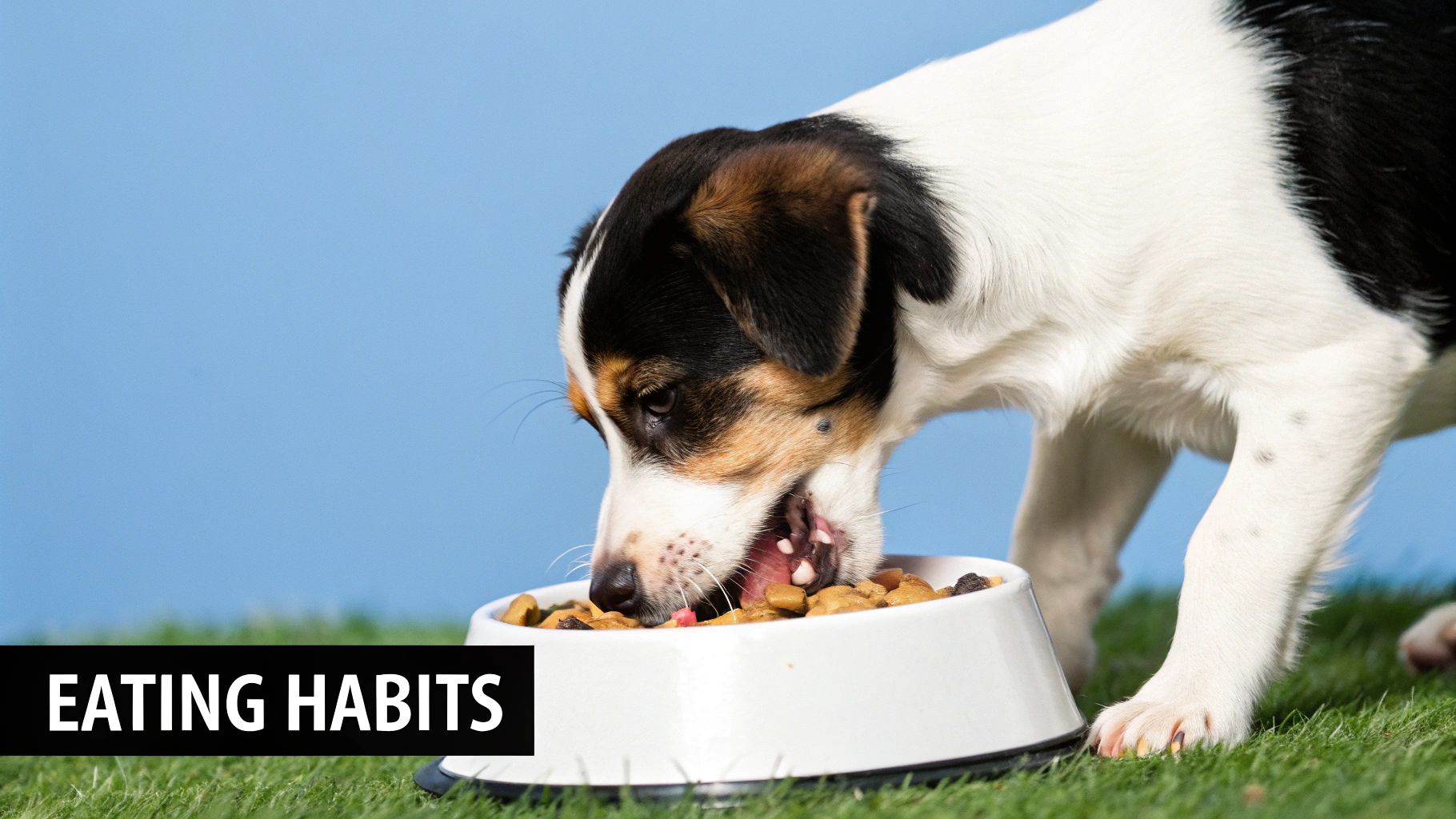
Most of the time, a gassy dog is just… a gassy dog. It’s a normal, if slightly smelly, part of life that’s usually tied to what they ate or how fast they wolfed it down. But what if the gas doesn’t stop?
If you’ve already tried switching their food and using a slow-feeder bowl with no luck, it might be time to look a little deeper. Persistent, severe flatulence can be a smoke signal for a more serious fire smoldering inside your dog’s body. At this point, the gas isn't the problem itself—it's a symptom.
Think of it like this: an occasional toot is just a minor traffic snarl in your dog’s digestive system. Chronic, room-clearing gas, on the other hand, could be a sign of a major pile-up or a serious mechanical failure that needs a professional’s touch. It's one of the clearest ways your dog can tell you something is wrong on the inside.
Underlying Conditions That Cause Chronic Gas
A handful of medical issues can really throw a dog's digestive system out of whack, leading to a constant state of gassiness. These problems aren't just about food fermentation; they often involve inflammation, poor nutrient absorption, or even infection. If your dog's gas is relentless and exceptionally foul, one of these conditions could be to blame:
- Inflammatory Bowel Disease (IBD): This is a condition where the gastrointestinal tract is chronically inflamed. This inflammation gets in the way of proper digestion and nutrient absorption, causing symptoms like gas, diarrhea, and vomiting.
- Hidden Food Allergies or Intolerances: We're not just talking about a mild sensitivity here. A true food allergy triggers an immune system response that can wreak havoc on a dog's gut, leading to significant GI upset and, you guessed it, a ton of gas. Our guide on what to look for in dog food is a fantastic resource for starting the journey to find a diet that works for them.
- Pancreatitis: When the pancreas becomes inflamed, it can't produce the digestive enzymes needed to break down fats and other nutrients. This undigested food ferments in the gut, causing painful gas and bloating.
- Gastrointestinal Infections: Nasty bacterial or viral infections can completely disrupt the delicate balance of your dog's gut microbiome. This imbalance can lead to a whole host of digestive issues, with gas being one of the most common signs.
When gas is a symptom of an underlying illness, it rarely travels alone. The key is to look for other warning signs that accompany the flatulence.
Red Flags That Require a Vet Visit
Normal gassiness is just that—gas. It shouldn't come with any other signs of illness. But if you notice your dog's flatulence is paired with any of the following symptoms, it's time to stop guessing and start acting. You need to call your veterinarian immediately.
Critical Warning Signs:
- Vomiting or Chronic Diarrhea
- Sudden and Unexplained Weight Loss
- A Hard, Distended, or Painful Abdomen
- Extreme Lethargy or Weakness
- Loss of Appetite or Refusal to Eat
- Blood in Their Stool
When you see these signs together, you’re likely looking at a serious problem that requires a professional diagnosis. It’s natural to feel scared, but catching these issues early is the best thing you can do for your dog. It gives your vet the best possible chance to figure out what’s wrong and get your companion the help they need. Don’t wait it out—prompt action is absolutely critical.
Understanding The Urgent Threat Of Bloat
We need to talk about something serious. While a bit of doggy gas is usually just a smelly nuisance, there's a related condition that is anything but harmless: bloat, or Gastric Dilatation-Volvulus (GDV). This isn't just a bad case of gas. Bloat is a rapidly escalating, life-threatening emergency.
Here’s the difference: simple gas is just air moving through the intestines. Bloat is a catastrophe in the stomach. The stomach suddenly fills with gas, like an overinflated balloon, and then twists on itself. This twisting action immediately cuts off blood flow to the stomach and other vital organs, sending the dog into shock.
Think of it this way: normal gas is like a minor traffic jam in the digestive system that eventually clears. Bloat is a five-car pileup that shuts down the entire highway. Every single second counts.
Breeds at Higher Risk
Any dog can theoretically get bloat, but some breeds are built in a way that makes them much more susceptible. Dogs with deep, narrow chests have more space in their abdominal cavity, giving the stomach more room to stretch and, terrifyingly, to twist.
The breeds we worry about most include:
- Great Danes
- German Shepherds
- Standard Poodles
- Weimaraners
- Saint Bernards
- Basset Hounds
The numbers here are genuinely frightening. Research indicates that between 22% and 24% of all large and giant-breed dogs will experience bloat at some point. For Great Danes, the lifetime risk is nearly 37%, and for them, the odds of the deadly twist (GDV) happening are a staggering 42%. Even with immediate, aggressive emergency surgery, mortality rates can be as high as 10% to 60%. You can read the full research about these bloat risk factors to get a deeper sense of the threat.
The image below shows what causes normal intestinal gas, which is very different from the swallowed air that leads to bloat.
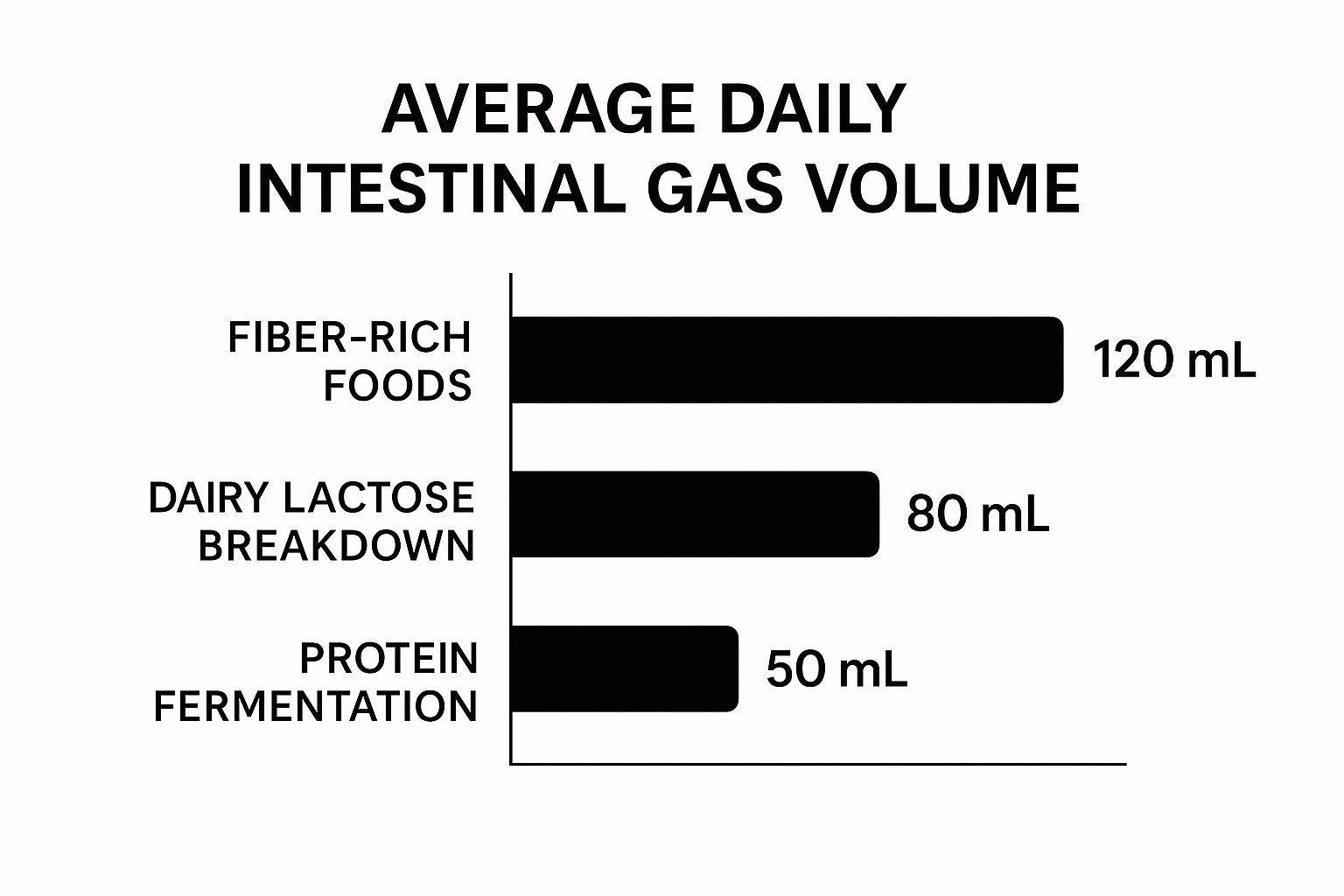
As you can see, things like fiber-rich foods create gas during digestion in the intestines. But remember, the gas that causes bloat primarily comes from swallowed air that gets trapped in the stomach.
Simple Gas vs. Life-Threatening Bloat
It can be hard to tell what's a minor issue and what's a five-alarm fire. This table breaks down the crucial differences between a simple case of gas and the emergency signs of bloat.
| Symptom | Simple Gas (Flatulence) | Bloat (GDV Emergency) |
|---|---|---|
| Urgency | Non-urgent. Annoying but not dangerous. | Extreme medical emergency. Go to a vet NOW. |
| Behavior | Dog is acting normally, just passing gas. | Frantic pacing, obvious distress, can't settle. |
| Vomiting | May occasionally vomit, but it's productive. | Retching or trying to vomit but nothing comes up. |
| Abdomen | Soft, normal belly. | Hard, swollen, tight abdomen (like a drum). |
| Other Signs | Smelly toots. | Excessive drooling, pale gums, weakness, collapse. |
Knowing these signs isn't just helpful—it can be the difference between life and death for your dog.
Critical Symptoms Of Bloat
If you see the following signs, you are in the middle of a true emergency.
Do not wait. Do not "watch and see." Go to the nearest 24/7 emergency veterinary hospital immediately. Bloat can kill a perfectly healthy dog in a few short hours.
Keep an eye out for these urgent red flags:
- Retching without vomit: Your dog is trying desperately to throw up, but only spit or foam comes out.
- A hard, swollen abdomen: Their belly looks visibly bigger and feels tight to the touch.
- Pacing and restlessness: They are clearly in pain, can't lie down, and seem panicked.
- Drooling excessively
- Pale gums
- Sudden collapse
Being able to spot the difference between a smelly inconvenience and a deadly crisis is one of the most important things you can learn as a dog owner. It empowers you to act fast when it truly matters.
Actionable Steps to Manage and Prevent Gas
Alright, now that we know why our dogs can clear a room, what can we actually do about it? The good news is that creating a less gassy home usually comes down to making a few simple, practical tweaks to your dog's daily life. It’s all about helping their digestive system work the way it's supposed to.
Let's start with the most obvious culprit: their food bowl. A highly digestible food is your greatest ally here. When you're reading labels, look for high-quality, named meat proteins (like "chicken" or "beef," not just "meat meal") as the very first ingredient. Try to steer clear of foods that are heavy on common fillers like corn, soy, or an overabundance of legumes like peas and beans, which can be tough for some dogs to break down.
If you suspect a food sensitivity is at play, a limited-ingredient diet can sometimes work wonders. These issues often go hand-in-hand with skin problems, so paying attention to both can be key. For more on this connection, you can check out our guide on the best dog food for skin allergies.
Feeding Routine and Exercise
Believe it or not, how you feed your dog can be just as important as what you feed them. If your dog acts like a vacuum cleaner at mealtime, they’re swallowing a ton of air right along with their kibble.
- Try a Slow-Feeder Bowl: These bowls are designed with built-in mazes and obstacles. They turn dinner into a fun challenge, forcing your dog to slow down and, more importantly, swallow way less air.
- Split Up Meals: Instead of one massive dinner, try feeding two or even three smaller meals throughout the day. This puts less strain on their digestive system all at once.
Don't forget the power of a good walk! Regular, moderate exercise is fantastic for getting the gut moving. A brisk walk helps stimulate what's called intestinal motility, which is just a fancy way of saying it helps gas pass through naturally instead of building up into a smelly situation.
It's a surprising fact, but for a life-threatening condition like bloat, the main problem is actually swallowed air, not gas produced by digestion. This really drives home why slowing down your dog's eating speed is so critical for their overall health. You can discover more insights about bloat causes on Pet Health Network.
Finally, a quick word on supplements. Things like probiotics or digestive enzymes can be incredibly helpful for some dogs, but they aren’t a magic bullet for everyone. It’s always best to chat with your veterinarian before adding anything new to your dog’s diet to make sure it’s safe, effective, and right for their specific needs.
Frequently Asked Questions About Dog Gas
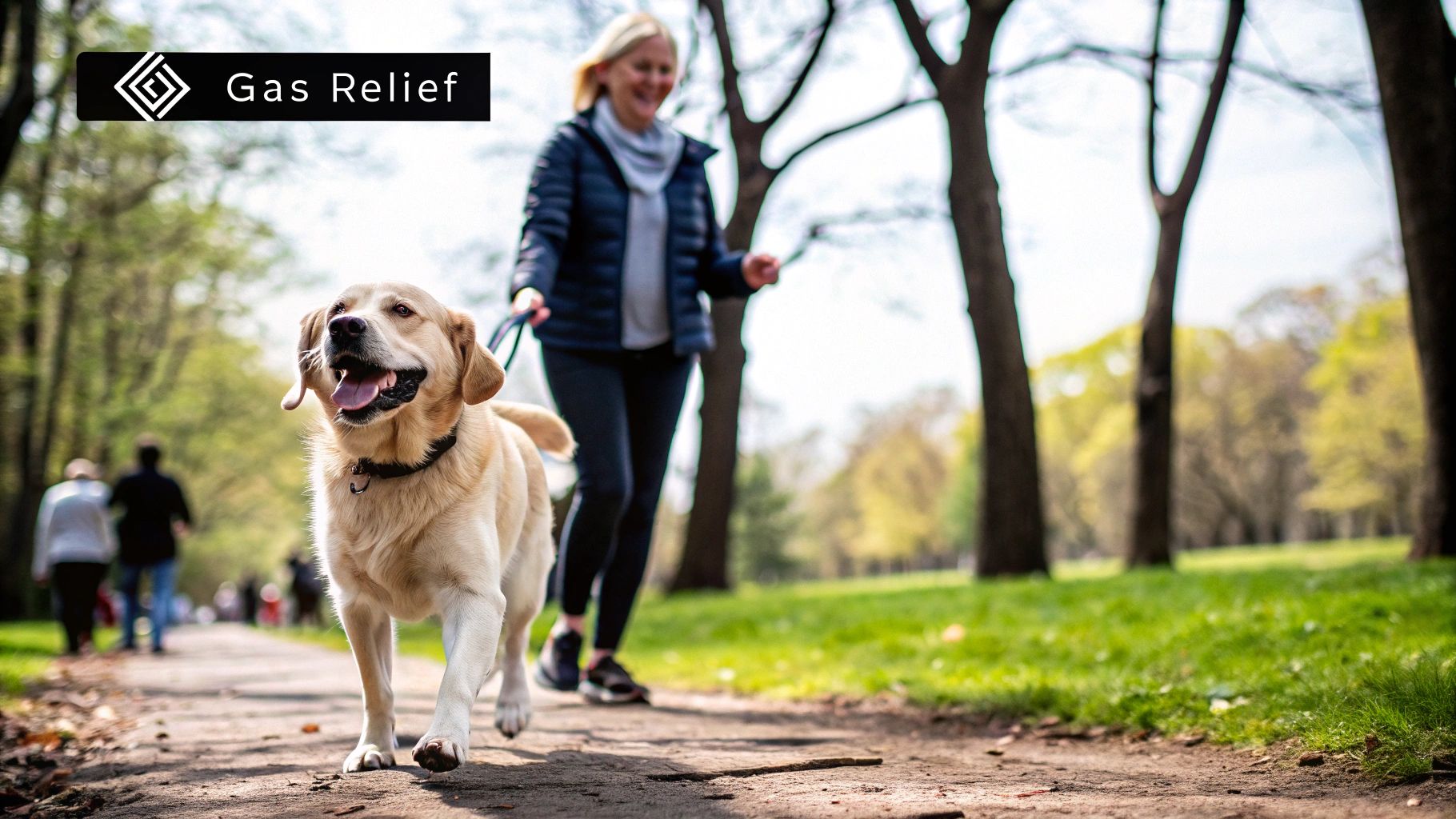
Even with all the causes covered, you might still have a few lingering questions about your dog's, shall we say, aromatic habits. It’s completely normal. Let’s tackle some of the most common questions we hear from dog owners just like you.
Can Certain Dog Treats Cause More Gas?
You bet they can. Many of the colorful, fun-shaped treats on store shelves are loaded with things that don't always agree with a dog's digestive system. Think high-fat or high-sugar content, or fillers like corn and soy that can ferment in the gut and produce gas.
Even seemingly "healthy" treats like jerky can be high in glycerin, and processed chews like rawhide can be tough for some dogs to break down. The best bet is to stick with simple, single-ingredient treats or look for brands that focus on digestive health. As with any new food, introduce new treats one at a time and in small amounts to see how your dog reacts.
Should I Give My Dog Probiotics for Gas?
Probiotics can be a game-changer for some gassy dogs. The goal is to introduce beneficial bacteria to balance out their gut microbiome, which in turn can lead to smoother digestion and less flatulence. But, it's not a magic bullet for every dog.
The success of a probiotic really hinges on using the right strain for the right problem. Before you run out and buy a supplement, it's essential to talk to your vet. They can help you figure out if probiotics are a good idea for your dog and recommend a quality, canine-specific product that will actually work.
Is It Normal for My Puppy to Be Very Gassy?
A gassy puppy is a pretty common sight (and smell). Their little digestive systems are still under construction and learning how to process food efficiently. Puppies are also notorious for eating way too fast—swallowing a ton of air in the process—and for tasting everything they find on the ground.
While some gas is normal, keep an eye out for red flags. If the gas is constant, exceptionally foul, or comes with diarrhea, a pot-belly look, or slow growth, it's time for a vet visit. Intestinal parasites are very common in puppies and can be a hidden cause of serious gas.
Does My Dog's Age Affect How Gassy They Are?
Absolutely. Age plays a significant role. As dogs enter their golden years, their whole system starts to slow down, including their digestion. The gut doesn't move as quickly, and they may not absorb nutrients like protein and fat as efficiently as they did in their prime.
This change often leads to an uptick in gas. Switching to a high-quality, easily digestible senior dog food can make a world of difference. Of course, any sudden or dramatic increase in gas in an older dog should always prompt a call to your vet to make sure a more serious health issue isn't brewing.
At Joyfull, we believe your pet deserves the best. That’s why we create formulas with clean ingredients and high-quality proteins, all reviewed by our in-house veterinary advisor. Explore our products and give your best friend the gift of better wellness at https://joyfullpet.com.
